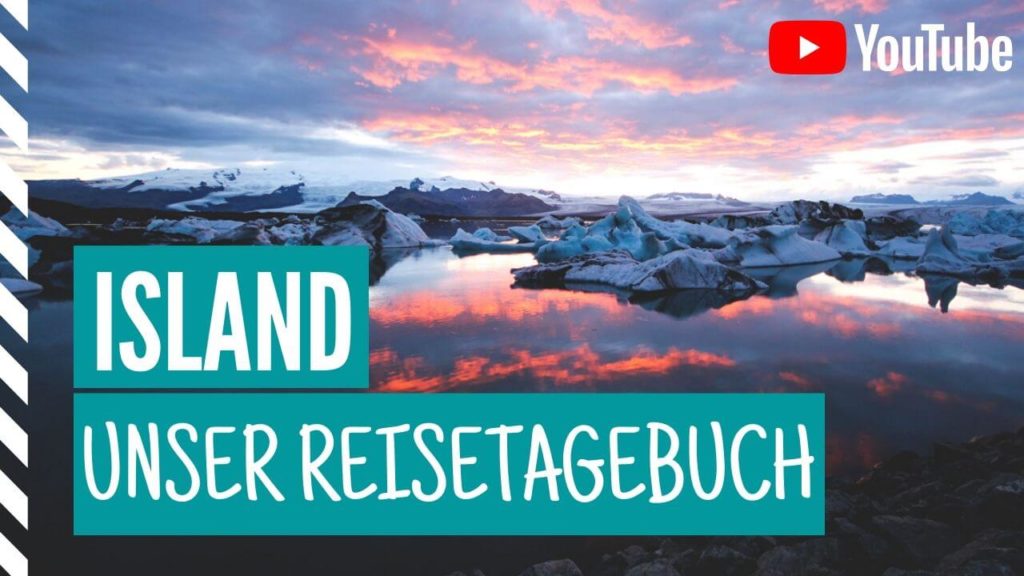Iceland and camping? A really good decision. Depending on the time of year, camping in Iceland is really easy and comfortable. We wanted to have the real adventure during our tour through Iceland and forgo accommodation. Of course, this is also because hotels in Iceland are simply incredibly expensive. If you’re wondering how much a trip to Iceland costs, take a look at our overview ▷ Costs in Iceland.
We can absolutely recommend camping in (or should we say in?) Iceland; it was a lot of fun, too. There are more than 200 campsites on the island, so you’ll always find a place to sleep. Today we’ll tell you what you need to pay attention to when camping in Iceland and give you a few cool tips.
Other important Iceland topics:
- Driving in Iceland
- Camping & Camping in Iceland
- Iceland’s Sights
- Currency in Iceland
- Best time to travel to Iceland
- Routes for 7 and 14 days
- Costs for our trip
- Our Iceland country page
- The South of Iceland
- The Vatnsnes Peninsula
- The North of Iceland
- The East of Iceland
- The Westman Islands
- The Southeast of Iceland
- Reykjavik Highlights & Tips
- The Golden Circle
- Other important Iceland topics:
- 1. The right tent for Iceland
- 2. Conclusion: Trek Escape trekking tent
- 3. Sleeping pad, sleeping bag, etc.
- 4. Can you camp anywhere?
- 5. Is the Camping Card worth it?
- 6. Camping in Iceland – Important information
- Iceland Camping – The article as a podcast
- Our travel diary on YouTube
1. The Right Tent for Iceland
For a long time, our packliste for Iceland didn’t include a tent. We searched and pondered for a long time which tent would be best. Such a tent has to be able to withstand storms, rain, and cold. Since we were absolute beginners in this field, we had to do a lot of research. What do you have to pay attention to when buying a tent? Which factors are important? Opinions differ here. Some people go for a €40 tent from Decathlon, others for a €500 professional tent.
We wanted to stay somewhere in between. In Facebook groups, we read posts about tents that were simply swept away in storms. Reports of tents that were neither waterproof nor windproof. As outdoor beginners, we weren’t interested in this kind of thing. After all, our first real outdoor trip shouldn’t be a disappointment.

On the road with an ultralight tent
Fortunately, we were supported by the company Outdoorer* for our trip. Now we had a very experienced outdoor partner at our side. The team recommended the ultralight Trek Escape* trekking tent. And by ultralight, we mean ultralight. The tent weighs just 1.7 kg when packed and fits into any medium-sized backpack. This is exactly what we were looking for.
This tent is also super quick to set up. Once we got the hang of it, it took us less than 10 minutes to set up the tent and its interior. We were a bit skeptical at first, as the outer tent only has a water column of 2000 mm. Would it withstand the Icelandic rain? The poles have a surface finish and are made of high-quality duralumin. You can tell. The seams are sealed with silicone and are made of special cotton thread.
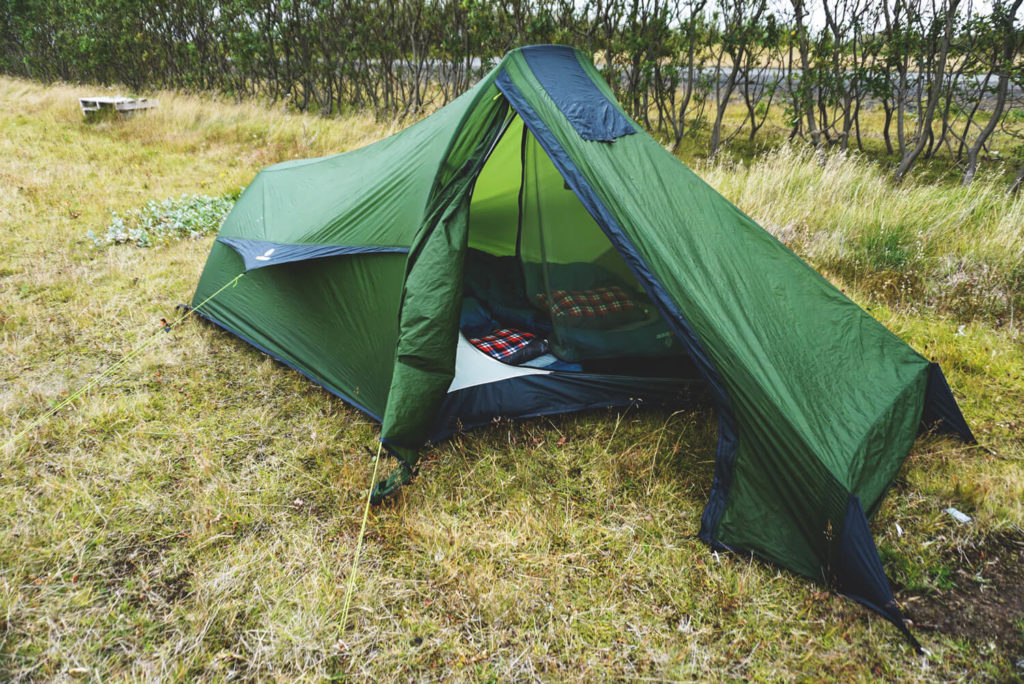
It should be noted that the tent is only large enough for two people. We were able to leave our luggage in the rental car. Would it have fit in the tent? Absolutely not! There’s only a small vestibule for storing smaller items. Our shoes, a few books, and something to drink were always there. You also don’t have much room to move around in the tent because it’s very flat.
This flat and streamlined shape can withstand storms and directs the wind very well. Therefore, you should always pitch the narrow side facing the wind. Unfortunately, we don’t know whether this tent could be used in the Icelandic winter. According to the description, it should work. To secure the tent even better, we got some strong aluminum pegs and guy ropes*.
2. Conclusion: Trek Escape Trekking Tent
For our 14-day trip to Iceland, the tent absolutely lived up to its promise. No moisture penetrated the interior, even though the exterior was constantly wet/damp. Heavy rain was no problem for the trekking tent; it even withstood a strong storm. We’re impressed by the pack size and weight. The quick setup is also a definite plus. It could be a bit larger, so you have a bit more space inside. Nevertheless, it’s a really good, high-quality tent that we’ll continue to use in the future.
Update 01/2025: We’re still using the tent for our outdoor trips and love it. It’s obviously not a spacious tent with a lot of room, but it does what it promises and is super quick to set up and take down. So far, we haven’t encountered any flaws and we’re happy to take the tent with us on our trips.
3. Sleeping Pad, Sleeping Bag, etc.
We didn’t want to sleep on completely flat sleeping pads. But we also didn’t want to lug around bulky air mattresses. We were truly amazed at what’s available on the outdoor market today. So we ended up getting two ultralight, self-inflating sleeping pads with a height of 5 cm. The Trek Bed 2* really doesn’t weigh a gram too much and packs down nicely.
A sleeping pad weighs just 799 grams. Super cool, right? We were also able to stow the pads very easily in our backpack. Based on the community’s recommendation, we also got aluminum pads* for the sleeping pads beforehand. This allowed us to insulate the heat even better. These weigh only 90 grams and cost just €5.
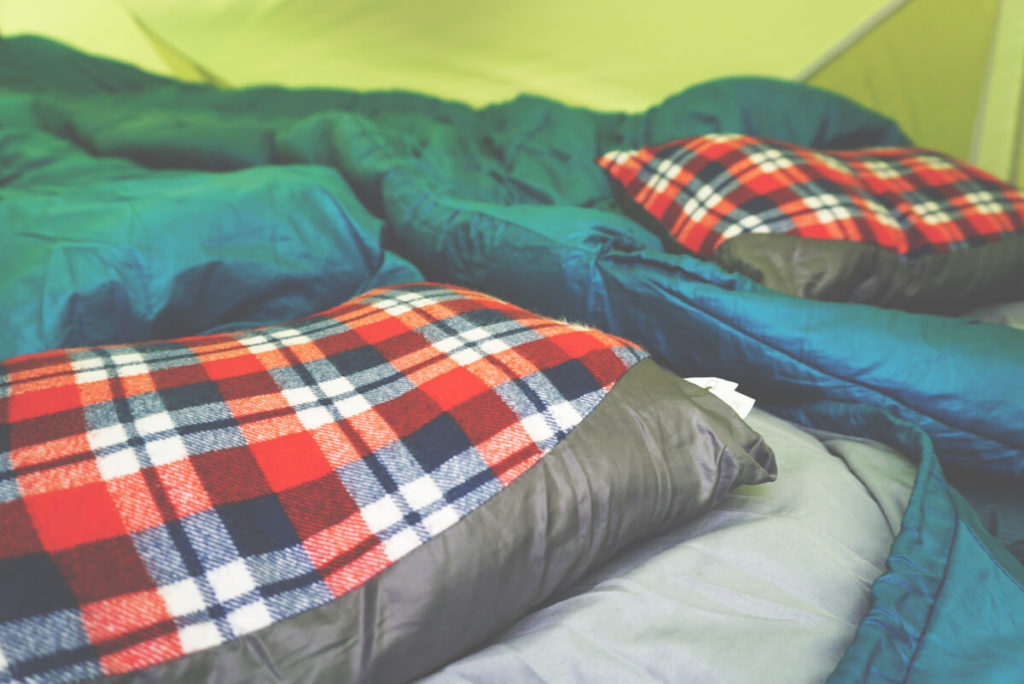
Our sleeping bag
For our sleeping bags, we opted for the Festival Night 2* mummy sleeping bag. This is suitable for summer and the transitional seasons of spring and fall. The comfort temperature is 0 to 5 degrees Celsius. In Iceland, it was always really cold in the evenings, at 4 to 6 degrees Celsius. The A&O is a decent sleeping bag that will keep you warm overnight. The zipper and Velcro fasteners are of very high quality. The shell is made of 70D polyester, and the fitter is made of polyester Silk Touch. We found the material to be very comfortable.
At 1.6 kilograms, the sleeping bag isn’t too heavy, but it’s not all that light either. Rolled up and packed, the sleeping bags took up a lot of space. There were nights when we froze, and there were nights when it was really nice and warm. What caused that in the end? We have no idea. If you’re a real cold person, you might want to set the comfort zone to -5 degrees Celsius.
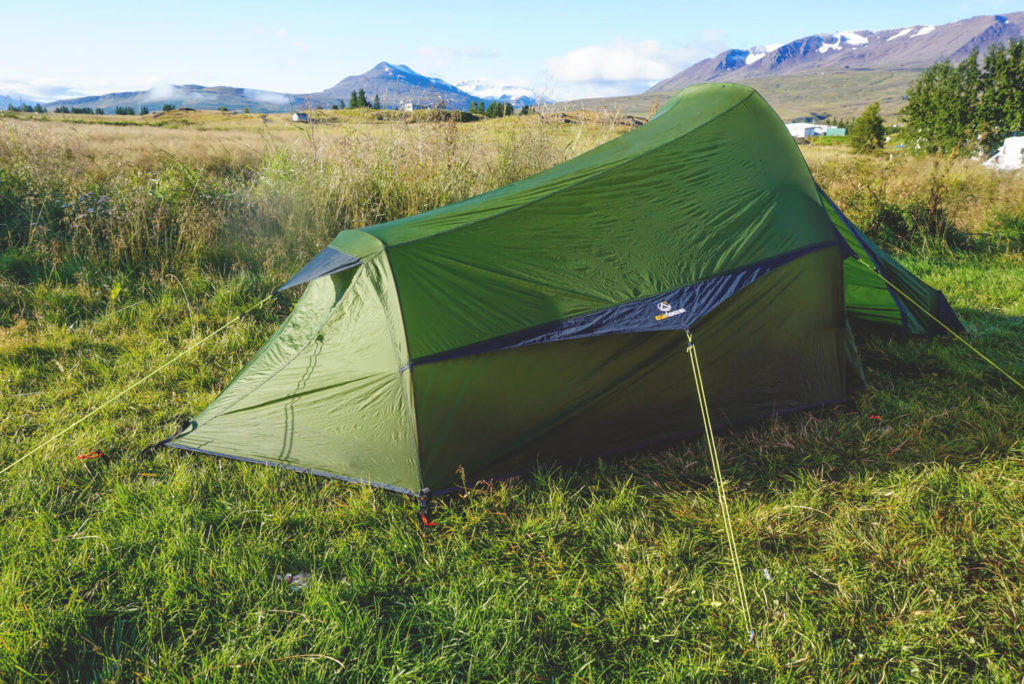
Useful Gadgets
And since we wanted at least a little comfort, we took two travel pillows* with us. These are easy to roll up and stow away. This way, each of us had a small pillow for the night. Definitely recommended. We were also able to attach a small LED lamp* to the tent. This allowed us to read in the evening. The lamp only needed three batteries (there are also USB ones). From the outside, our tent lit up as brightly as the moon, making it easy to find in the dark. More on this here: Iceland Packing List.
4. Is it allowed to camp anywhere?
Officially, wild camping is prohibited in Iceland. Over the years, the laws have become stricter, placing greater emphasis on compliance. We only stayed at campsites because we could use the toilets, showers, kitchens, and other amenities there. In these temperatures, it’s nice to be able to sit in a warm room. Furthermore, caravans, campers, and the like are no longer allowed to park outside of campsites. Here and there, we saw some people spending the night in parking lots. We still recommend staying at official campsites and taking the rules seriously.
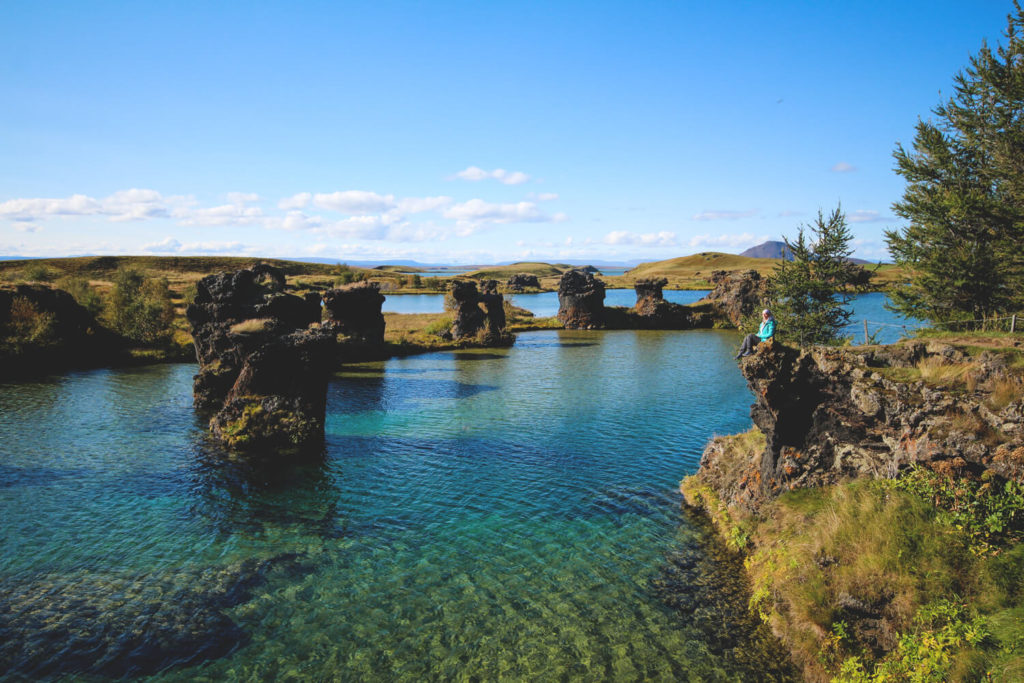
In Iceland, land is seemingly privatized. You are only allowed to camp there if you have official permission from the landowner. In the wilderness (where no people live permanently) and in the highlands, you are allowed to pitch your tent for one night. If there is no public campsite nearby, wild camping for one night is fine. But only if you are not illegally on private land. In the three national parks (Vatnajökull National Park, Þingvellir National Park, and Snæfellsjökull National Park), tent camping is prohibited. All these rules are subject to change at any time.
5. Is the Camping Card worth it?
We already reported on the Camping Card* in our article “Camping in Iceland.” With the card, you can pitch your tent or park your caravan at 42 different campsites in Iceland. It costs €149 and is valid for two people and up to four children during the season (until September 15th). Extras such as showers, laundry, etc., are not included in the price.
You also pay the Icelandic tourist tax of 333 Krona per night and unit (tent, caravan). For 14 nights at a campsite, this would be an additional €35 in taxes. In general, a campsite in Iceland often costs between 1,000 and 2,000 ISK per person per night. For us, the Camping Card was already worth it after the 8th night. In total, we camped at a campsite 11 times. We had accommodation for the other 3 nights.
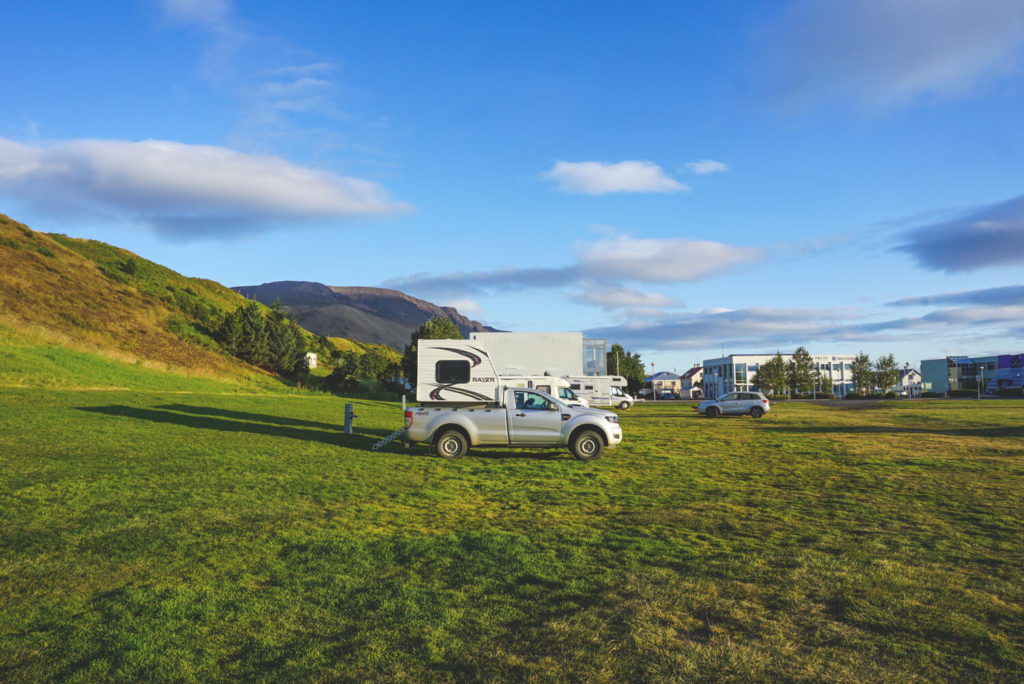
6. Camping in Iceland – Important Information
Like anywhere else in the world, it’s important to leave your spot clean. Please don’t leave any trash on the campsite. Make sure to turn the noise down after 10 p.m. Most travelers are exhausted and want to sleep in peace. Party people aren’t welcome at campsites. Also, keep some distance from your neighbor’s tent and be careful with the guy ropes. I tripped over a few myself and almost knocked over my neighbor’s tent. Keep an eye out for “camping traffic.” Avoid fires or cooking in the tent. The material can catch fire very quickly. Then, at the very latest, you’ll be left without a roof over your head.
You should also always keep an eye on the weather. Also, listen to the advice of the locals. The weather in Iceland is changeable and extremely changeable. A severe storm was forecast for our first night, so we decided to look for accommodation. So pay attention to the weather forecast and always stay informed about the current situation. On the Safe Travel website, you can find information about the weather and road closures. As you can see, camping in Iceland is really not difficult if you follow a few hints and tips.
Iceland Camping – The Podcast
Click the button below to load the content from www.podbean.com.
Load Content
Our Travel Diary on YouTube
